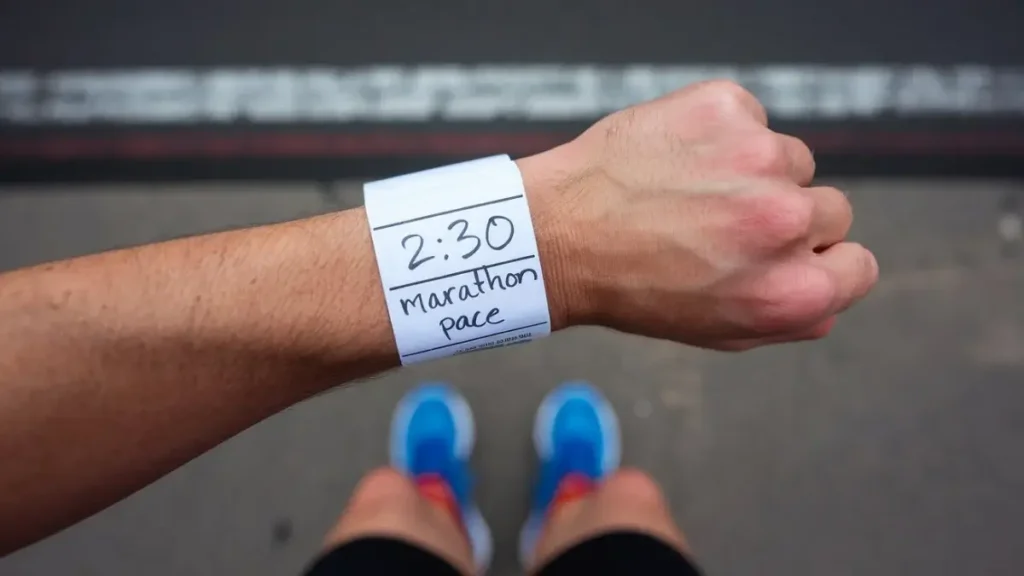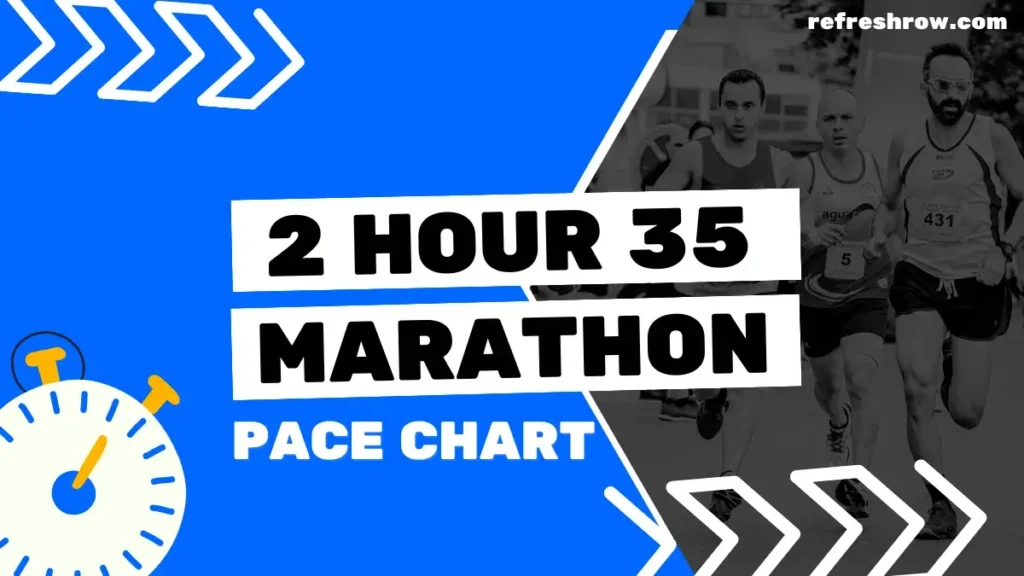To run a 6 hour marathon you need to run at a pace of 13:44 per mile or 8:32 per kilometer.
Following the splits below (and shaving off a second), you’ll run a sub 6:00 marathon.
I’d recommend aiming to run 1-2 minutes ahead of the split target time from 10 miles, as you’ll likely come up against crowding on race day.
6:00 Marathon Pace in Miles
| Mile | Split |
|---|---|
| 1 | 13:44 |
| 2 | 27:28 |
| 3 | 41:12 |
| 4 | 54:55 |
| 5 | 1:08:39 |
| 6 | 1:22:23 |
| 7 | 1:36:07 |
| 8 | 1:49:51 |
| 9 | 2:03:35 |
| 10 | 2:17:18 |
| 11 | 2:31:02 |
| 12 | 2:44:46 |
| 13 | 2:58:30 |
| 14 | 3:12:14 |
| 15 | 3:25:58 |
| 16 | 3:39:41 |
| 17 | 3:53:25 |
| 18 | 4:07:09 |
| 19 | 4:20:53 |
| 20 | 4:34:37 |
| 21 | 4:48:21 |
| 22 | 5:02:04 |
| 23 | 5:15:48 |
| 24 | 5:29:32 |
| 25 | 5:43:16 |
| 26 | 5:57:00 |
| 26.2 | 6:00:00 |
Download
6:00 Marathon Pace in KM
| KM | Split |
|---|---|
| 1 | 8:32 |
| 2 | 17:04 |
| 3 | 25:36 |
| 4 | 34:08 |
| 5 | 42:40 |
| 6 | 51:11 |
| 7 | 59:43 |
| 8 | 1:08:15 |
| 9 | 1:16:47 |
| 10 | 1:25:19 |
| 11 | 1:33:51 |
| 12 | 1:42:23 |
| 13 | 1:50:55 |
| 14 | 1:59:27 |
| 15 | 2:07:59 |
| 16 | 2:16:31 |
| 17 | 2:25:02 |
| 18 | 2:33:34 |
| 19 | 2:42:06 |
| 20 | 2:50:38 |
| 21 | 2:59:10 |
| 22 | 3:07:42 |
| 23 | 3:16:14 |
| 24 | 3:24:46 |
| 25 | 3:33:18 |
| 26 | 3:41:50 |
| 27 | 3:50:22 |
| 28 | 3:58:53 |
| 29 | 4:07:25 |
| 30 | 4:15:57 |
| 31 | 4:24:29 |
| 32 | 4:33:01 |
| 33 | 4:41:33 |
| 34 | 4:50:05 |
| 35 | 4:58:37 |
| 36 | 5:07:09 |
| 37 | 5:15:41 |
| 38 | 5:24:13 |
| 39 | 5:32:44 |
| 40 | 5:41:16 |
| 41 | 5:49:48 |
| 42 | 5:58:20 |
| 42.2 | 6:00:00 |
Download
Other Marathon Pace Charts
Targeting a different time?
Check out the Full Marathon Pace Chart in Miles or KM
Or select a specific finishing time below:
| 3:00 | 4:00 | 5:00 | |
| 3:05 | 4:05 | 5:15 | |
| 3:10 | 4:10 | 5:30 | |
| 3:15 | 4:15 | 5:45 | |
| 3:20 | 4:20 | 6:00 | |
| 3:25 | 4:25 | 6:15 | |
| 2:30 | 3:30 | 4:30 | 6:30 |
| 2:35 | 3:35 | 4:35 | 6:45 |
| 2:40 | 3:40 | 4:40 | 7:00 |
| 2:45 | 3:45 | 4:45 | |
| 2:50 | 3:50 | 4:50 | |
| 2:55 | 3:55 | 4:55 |
Training for a 6:00 Marathon
Is 6:00 a Good Marathon Time?
Well, what do the stats say?
Run Repeat conducted a study that contains 19,614,975 marathon results from more than 32,335 races across the globe, here is how a 6:00 marathon compares against age and gender for the races recorded:
| Overall | You’re faster than 6.3% of all runners. |
| Male | You’re faster than 4.2% of males. |
| Female | You’re faster than 9.1% of females. |
| <20 | You’re faster than 8.1% of under 20s. |
| 20-29 | You’re faster than 3.8% of 20-29 year olds. |
| 30-39 | You’re faster than 3.8% of 30-39 year olds. |
| 40-49 | You’re faster than 4.7% of 40-49 year olds. |
| 50-59 | You’re faster than 8.4% of 50-59 year olds. |
| >60 | You’re faster than 19.7% of over 60s. |
Training Runs and Paces for a 6:00 Marathon
To break a 6:00 marathon you’ll need to do some serious distance in your training, I recommend at least 10 miles (16km) per week.
You’re also going to need to make sure you’ve crossed off these milestones for other race distances:
- A 5k in 37:30
- A 10k in 1:18:10
- A half marathon in 2:44:00
Training Paces
| Pace | Mins per Mile | Mins per KM |
|---|---|---|
| Easy | 15:28 | 9:37 |
| Steady | 13:44 | 8:31 |
| 10k | 12:35 | 7:49 |
| 5k | 12:05 | 7:30 |
| 1 Mile | 11:13 | 7:00 |
Weekly Mileage Targets
| Target Mileage: | Gradually increase your weekly mileage from 6 miles (10 km) to a peak of 12 miles (19 km). |
| Incremental Increase: | Increase mileage by approximately 10% each week, with every fourth week as a recovery week where mileage is reduced by 20-30%. Make sure to taper for the last 1-2 weeks. |
Long Run Structure
| Total Distance: | Build up to long runs of 8-10 miles (13-16 km). |
| Segment Example: | First 3 miles (5 km): Easy pace, heart rate 140-150 bpm (approximately 16:45/mile or 10:25/km). Next 1 mile (1.6 km): Fast pace at 11:20/mile (7:02/km). Next 3 miles (5 km): Medium effort, heart rate around 160 bpm (approximately 12:30/mile or 7:45/km). Final 3 miles (5 km): Return to an easy pace (16:45/mile or 10:25/km). |
Why This Works: Incorporating varied paces within long runs enhances lactate tolerance, which helps on race day when you’ve got to maintain pace despite feeling fatigued. By practicing surges during a run, you can build up your physical and mental resilience (lots of elite marathon runners use these strategies during their training)
Alternating Long Runs: Alternate between structured long runs (easy/fast segments) and easier long runs. For easier long runs, maintain a steady, comfortable pace throughout, focusing on mileage rather than speed to aid recovery.
Speedwork Sessions
| Short Intervals: | – 400m repeats at 5:30 per interval (6:52/km). – Aim for 4-6 repetitions with equal time for recovery. |
| Mile Repeats: | – 1 mile repeats at 11:20 per mile (7:02/km). – Aim for 2-3 repetitions with a 1-2 minute recovery jog. |
| Longer Intervals: | – 2 mile repeats at 11:30 per mile (7:09/km). – Aim for 2-3 repetitions with a 2-3 minute recovery jog. |
Recovery and Rest Days
| Rest Days: | Include 1-2 rest days per week for proper recovery and to prevent overtraining. |
| Easy Run Days: | Include 1-2 easy run days per week at a relaxed pace of 17:00/mile (10:34/km), covering 2-3 miles (3-5 km) per day. Try to keep your heart rate below 140 bpm on easy days to ensure proper recovery and aerobic development. |
My Tips to Run a Sub 6:00 Marathon
Prioritize Time on Your Feet
If you’re newer to running, you’ll probably make the same mistake I did (and every runner before me) and focus on pushing your speed above all else.
If you’re aiming for a 6-hour marathon, you want to focus on time over speed.
Start by gradually increasing your weekly long runs, aiming to get comfortable running or walking for 4 to 5 hours at a time.
The key is to train your body to sustain the effort over time, so don’t stress about your pace early on – just keep moving and build that endurance base.
The more your body adapts to long durations, the easier it will be to maintain a consistent pace come race day.
Train with Back-to-Back Long Days
Because you’re going to be on your feet longer than other runners, you need to make sure you’re also building your stamina and resilience.
One great strategy I like to use is to incorporate back-to-back long training days.
For example, you can do a long run on Saturday followed by a longer walk or easy run on Sunday.
This simulates the fatigue you’ll experience in the later stages of a marathon and trains your body to keep moving, even when you’re tired.
It’s all about building that mental and physical stamina to push through the dreaded wall.
Master the Slow and Steady Approach
Let’s talk a little bit about mindset:
It’s time to think more like the tortoise, not the hare.
Mentally accept that your pace will be slow and steady – and that’s okay because that gets you across the finish line.
Focus on maintaining a rhythm you can sustain for hours without overexerting yourself.
The big mistake beginners often make (that you’ve probably heard before) is starting too fast and burning out early.
Stick to a comfortable pace, even when you feel fresh at the start.
Aim for consistency!
Use Low-Heart-Rate Training
Low-heart-rate training can sound complicated, but at its core, it’s really simple (and powerful!)
All it involves is running at a pace that keeps your heart rate in a “lower zone”.
(around 65-75% of your maximum heart rate)
Use an online calculator to work out this zone, and then track your heart rate on your training run on your sports watch.
If it’s above the zone, slow down a little.
If it’s below, speed up.
It’s that simple.
The reason runners (including me) use it is it helps you build a strong aerobic base without pushing your body too hard.
Over time, you’ll find you can maintain a steady pace for longer periods without feeling fatigued.
If you feel like you’re not improving from your training, give low heart rate training a go.


Row Brown is the founder of Refresh Row. He is a keen marathon runner, his favorite being the London Marathon. He’s now set himself the mission of Running the Entire Length of Spain, which is scheduled for late 2024.


